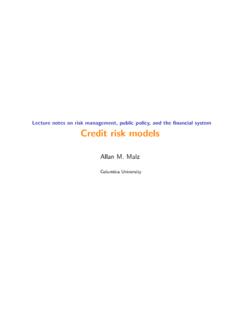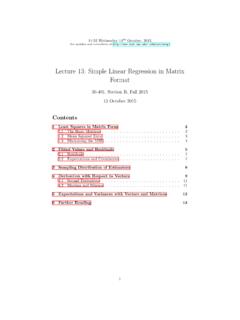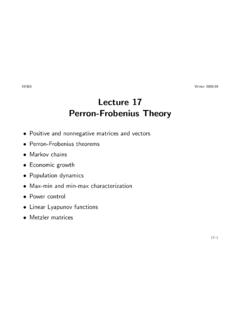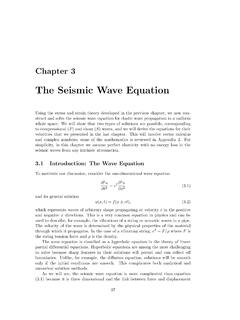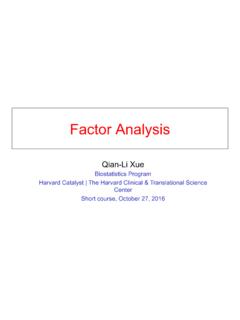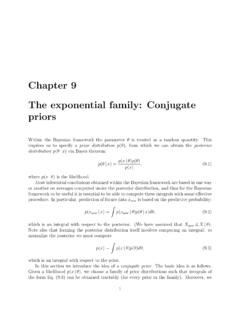Transcription of ELECTRICAL PROPERTIES OF CABLE INSULATION …
1 ELECTRICAL PROPERTIESOFCABLE INSULATION MATERIALSBRUCE S. BERNSTEINP aper-Insulated Lead Covered CablesPILC-FundamentalsINSULATION MATERIALS MEDIUM VOLTAGE Polyethylene[PE] Crosslinked PE [XLPE] Tree Retardant Crosslinked PE[TR-XLPE] Ethylene-PropyleneElastomers [EPR] PILC HIGH VOLTAGE Crosslinked Polyethylene PAPER/OIL Paper/Polypropylene [PPP] SF6 GasPILC CABLE is comprised of Paper strips wound overconductor with construction impregnated withdielectric fluid (oil) Long Service History Reliable/used since late 1800s Gradually being replaced by Extruded CablesPILC Paper derived form wood Wood Cellulose 40% Hemicellulose 30% Poor ELECTRICAL PROPERTIES Lignin 30% Serves as adhesive Cellulose must be separated from others Separation by bleaching sulfate/sulfite processPILC CELLULOSE- INSULATION Material HEMICELULOSE-Non-fibrous more polar losses higher vs.
2 Cellulose LIGNIN-Amorphous binds other components in the woodPaper/Oil Cellulose chemical structure more complex vs. PE orXLPE Oil impregnates the cellulose/superior dielectricproperties Different CABLE constructions for Medium vs. HighVoltagePaper/Oil LEAD SHEATH over CABLE construction Protects CABLE core Benefit: Superior barrier to outside environmentCOMPARISON OF CABLE INSULATIONMATERIALSPE / XLPE / TR-XLPE /EPR / PILCP olyethylene Low Permittivity: limits capacitive currents Low Tan Delta: Low Losses Very High dielectric strength (prior to aging) Easy to process/extrudeCrosslinked Polyethylene All of the above PLUS Improved mechanical PROPERTIES at elevated temperature does not melt at 105 C and above thermal expansion Improved water tree resistance vs.
3 PETree-retardant XLPE All of the above PLUS Superior Water tree resistance to XLPE TR-XLPE PROPERTIES brought about by Additives to XLPE Modifying the PE structure before crosslinking BothPaper/Oil PILC Long history of reliability some cables installed 60 or more years ! More tolerant of some common diagnostic tests toascertain degree of aging DC testingEPR Compromise of extruded CABLE PROPERTIES Permittivity, Tan Delta > XLPE s Dielectric strength slightly lower High temperature PROPERTIES : Equal to or > XLPE sAdvantages of Extruded Cables Reduced Weight vs. Paper/Oil Accessories more easily applied Easier to repair faults No hydraulic pressure/pumping requirements Reduced risk of flammability/propagation Economics Initial and lifetime costsExtruded Cables at High Temperatures PE/XLPE/TR-XLPE At elevated temperatures, crystalline regions start to melt Thermal expansion Physical/mechanical strength reduced At 105 C crystallinity gone.
4 PE flows XLPE and TR-XLPE crosslinking allows for maintenanceof FORM stability At high temperatures, crosslinks substitute for the crystallinity atlow temperatureExtruded Cables at High Temperature PE/XLPE/TR-XLPE Although Crosslinks serve as Crystallinity substitute, they do NOTprovide same degree of toughness moisture resistance Impact resistance Crosslinking assists in maintaining form stability, but notmechanical PROPERTIES Physical/ ELECTRICAL PROPERTIES change as temperature increasesExtruded Cables at High Temperature EPR Little to no crystallinity initially Form stability maintained due to presence of inorganic mineralfiller (clay) Physical and ELECTRICAL PROPERTIES change to some extent astemperature is increased Present day issue: operating reliability at higher temperatures polymer insulationPaper/Oil at High Temperature Cellulose: No significant thermal expansion compare with extruded cables Oil.
5 Some thermal expansion Degradation mechanisms differ at elevated temperatureThermal Degradation Paper/Oil Cellulose degradationconsistent from batch to batch Starts to degrade immediatelyunder thermal stress Moisture evolves Follows Arrhenius model Oil may form wax overtime(Polymerization) Extruded Degradation is polymerstructure related Degradation related toantioxidant efficiency Does not start untilstabilization system affected No water evolution No proven model existsSummary: Paper/Oil Natural Polymer Carbon/Hydrogen/Oxygen More polar Not Crosslinked Linear Fibrils/no thermalExpansion Oil expands thermally Thermal degradation ofcellulose at weak link (C-O) DC : No harmful Effect onAged CABLE -does remove weaklinkSummary: Extruded Materials Synthetic Polymer Carbon/Hydrogen Less Polar Branched chains Non-fibril Partly crystalline: much less forEPR Mineral fillers (EPR) Thermal expansion onheating Crosslinked Degrades at weakenedregions/crosslinks holdtogether form stability DC.
6 Latent problem -effectdepends on age (XLPE) ELECTRICAL PROPERTIES _____Determined By Physical and ChemicalStructure Polyolefin PROPERTIES ELECTRICAL PROPERTIES /General Dielectric constant Dissipation factor Volume resistivity Dielectric strength Polyolefin PROPERTIES Structure/property relationships Dielectric strength Partial Discharge Measurement MethodsElectrical PROPERTIES of Polyolefins The ELECTRICAL PROPERTIES of Polyolefins may be separated into twocategories: Those observed at low electric field strengths Those at very high field strengths LOW FIELD Dielectric constant/dissipation factor Conductivity Determines how good a dielectric is the INSULATION HIGH FIELD -Partial discharges (corona)
7 Controls functioning and reliabilityHow does Polymer INSULATION Respond toVoltage Stress Polar Regions tend to migrate toward electrodes Motion Limited INSULATION becomes slightly mechanically stressed Charge is stored PROPERTIES change Next few slides seek to picture events in idealizedtermsPolymerPolymer+ No fieldDC field applied,polymer becomespolarizedPOLARIZATION OF A POLYMER THAT CONTAINSMOBILE CHARGE CARRIERSE lectrodeORIENTATION OF POLYMERUPON APPLICATION OF VOLTAGE STRESSA lignment of Charge CarriersElectrodeElectrodeElectrodePolym erPolymerIDEALIZED DESCRIPTION orientation of polar functionality of polymer chains under voltagestressNo VoltageVoltage Stress AppliedNO FIELDFIELDAPPLIEDELECTRONICPOLARIZATIONA TOMIC POLARIZATIONORIENTATION POLARIZATIONE AWhat happens to Dielectric when FieldApplied?
8 POLARIZATION OF A POLYMER THAT CONTAINSSIDE GROUPS WITH PERMANENT DIPOLESNo fieldfield applied,polymer becomespolarizedSCHEMATIC OF SOME NORMAL MODESOF MOTION OF A POLYMER CHAINF irst ModeSecond ModeThird ModeApplication of Low Voltage Stress Dielectric Constant:Ability to hold charge Lower Polarity -> Lower K Dissipation Factor: Losses that occur as a result of energydissipated as heat, rather than ELECTRICAL energy > Polarity leads to > LossesDC vs. ACUnder DC- Polarization persistsUnder AC-Constant motion of thepolymer segments due to changingpolarityDielectric Constant TECHNICAL DEFINITION In a given medium ( for our purposes, in a specificpolymer INSULATION ) it is the Ratio of (a) the quantity of energy that can be stored, to (b) the quantity that can be stored in a vacuumDielectric Constant Relatively small if no permanent dipoles are present Approximately proportional to density Influenced by presence of permanent dipoles.
9 Dipoles orient in the electric field inversely proportional to temperature Orientation requires a finite time to take place is dependent upon frequency Relaxation time for orientation of a dipole is also temperaturedependentDielectric Constant The dielectric constant of the ELECTRICAL -insulating materialsranges from: a low of about 2 or less for materials with lowest ELECTRICAL -losscharacteristics, up to 10 or so for materials with highest ELECTRICAL lossesDielectric Constant of Common Polymers Polyethylene Polypropylene Butyl Rubber Poly MMA Nylon 66 PPLP (Oil-Impregnated).
10 Structure of Polymers ,Dupont and Tervakoski Literature Cellulose Acetate PVC Mylar (Polyester) Kapton (Polyimide) Nomex (Polyamide) Cyanoethylcellulose LOSSES From a materials perspective, losses result frompolymer chain motion Leads to heat evolution Chain motion influence on ELECTRICAL PROPERTIES aredepicted on next few slidesH AND H AS A FUNCTION OF FREQUENCYlog \\H H log \\\ maxDispersion Dipoles RIGIDLY attached - oriented by MAIN chain motion Dipoles FLEXIBLY attached - orientation of pendant dipoles and/or orientation by chain segmental motion (shows TWO dispersion regions)


